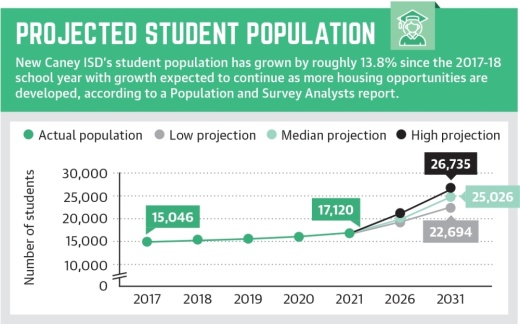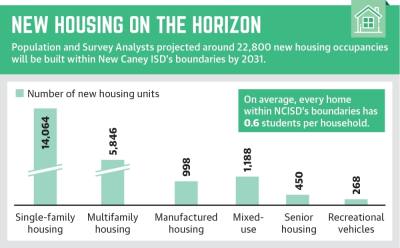NCISD’s student population stands at roughly 17,100 students as of April, according to district officials.
According to PASA Planning Director Kris Pool, the demographic firm studies existing and projected residential development and potential land uses for undeveloped land parcels to create student growth projections that aim to help school districts outline where new schools could be needed in the future.
Outside of 2020—during which the district’s annual growth rate dropped to 1% as students throughout the state shifted to remote learning due to the COVID-19 pandemic—NCISD’s student population has grown by an average of 4.6% annually since 2016, district officials said.
“Ignoring 2020, you can see how [student growth] really is continuing on an upward trajectory as many of those students [returned to classrooms],” Pool said.
Pool noted projections for growth would place NCISD’s student population in 2031 around 26,700 students in a high-growth scenario and 22,700 in a low-growth scenario.
According to PASA demographer Justin Silhavy, student growth scenarios are calculated, in part, by assessing housing developments under construction as well as projected new housing.
Silhavy said the western portion of the district is poised to see the most short-term growth with more than 4,000 new homes being constructed in The Highlands community, roughly 900 units being built in Maple Heights and around 500 units coming to The Landing.
Additionally, Silhavy said the northeast portion of the district will gain more than 2,400 new homes in the Tavola and Roman Forest communities, while the southern portion of the district will see roughly 900 new units in the Pepperdine, Northpark South and Royal Pines neighborhoods.
Silhavy also pointed to several undeveloped tracts of land that he said could provide additional housing in the future, including 1,500 acres of property—dubbed the Cheng Tracts—located north of the Grand Parkway as well as additional property owned by The Highlands’ developers located north of its current location.
“Looking out 10 years, over 22,000—closer to 23,000—homes are projected to be occupied [within the district’s boundaries],” Silhavy said, noting each housing unit within the district has an average of 0.6 students per home.
According to the projections, Pool said several schools within the district could reach 120% capacity within the next 10 years, including Crippen, Dogwood, Tavola and Oakley elementary schools; Keefer Crossing and White Oak middle schools; and New Caney High School.
Pool noted Crippen Elementary, which could potentially reach 120% capacity in the 2025-26 school year, could be relieved by a new school in the western portion of NCISD, while Dogwood, Tavola and Oakley could be relieved by a new school in the northeastern portion of NCISD.
Pool said an additional middle school and high school in the northern portion of the district would relieve projected capacity issues, but she noted the new schools would not be needed until the second half of the projection period, which begins with the 2027-28 school year.
“The district has done a good job in managing the growth, but there are things to be handled here in the next several years,” she said.






